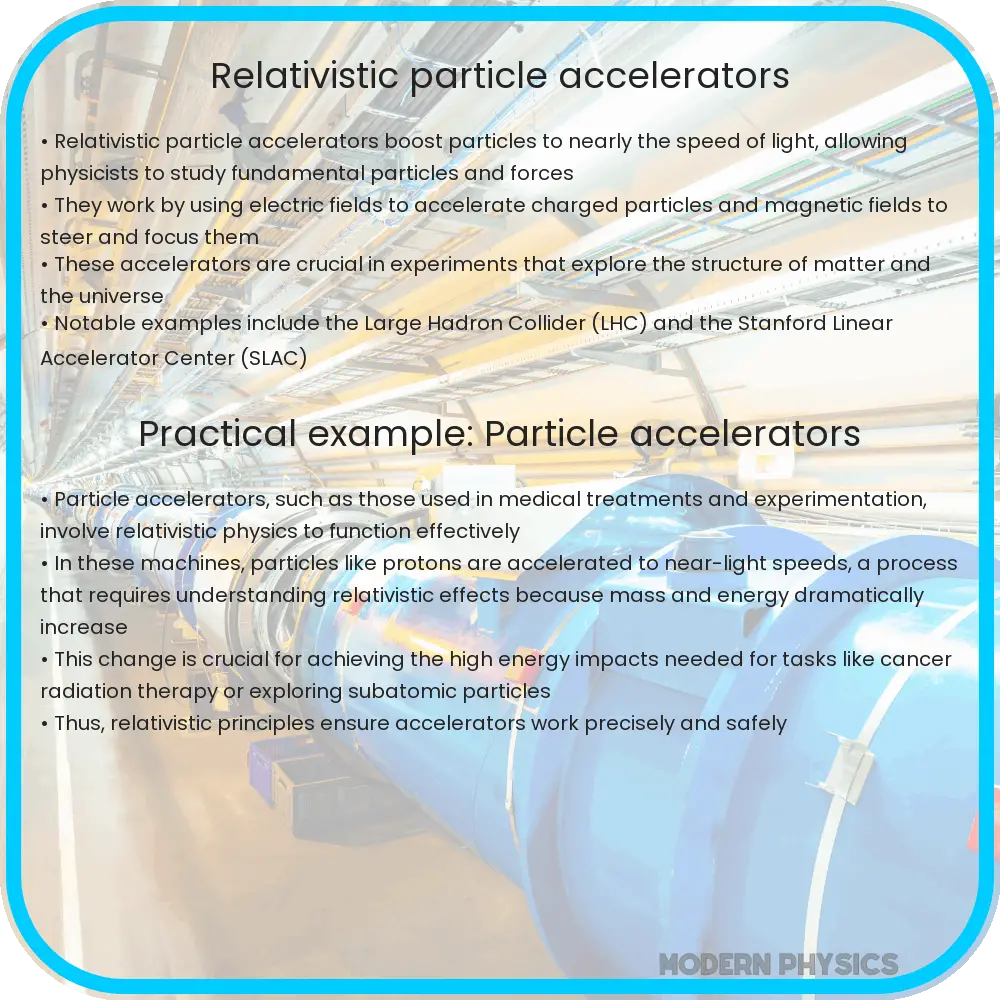Relativistic Particle Accelerators propel charged particles to speeds near light, revealing insights into mass increase, time dilation, and immense energy dynamics.

Relativistic Particle Accelerators: Speed, Collisions & Energy
Particle accelerators are fascinating machines, key to many discoveries in modern physics. They propel charged particles, such as electrons or protons, to high speeds—close to the speed of light. Understanding how these accelerators achieve this and what happens during particle collisions can illuminate many aspects of the physical universe.
Speed and Special Relativity
In a particle accelerator, particles are accelerated to relativistic speeds, meaning they move at a significant fraction of the speed of light. When particles reach these speeds, the principles of Einstein’s theory of special relativity become crucial.
\[ m = \frac{m_0}{\sqrt{1 – \frac{v^2}{c^2}}} \]
Where:
– \( m \) is the relativistic mass,
– \( m_0 \) is the rest mass,
– \( v \) is the velocity of the particle,
– \( c \) is the speed of light.
This equation demonstrates that as \( v \) approaches \( c \), the mass \( m \) increases dramatically, requiring more and more energy to continue accelerating the particle.
\[ t’ = \frac{t}{\sqrt{1 – \frac{v^2}{c^2}}} \]
Where:
– \( t’ \) is the dilated time,
– \( t \) is the proper time (time experienced by an observer at rest),
– \( v \) is the velocity of the particle,
– \( c \) is the speed of light.
These relativistic effects are not just theoretical; they have practical implications for the operation of particle accelerators.
Energy Considerations
At relativistic speeds, the energy involved is immense. The total energy of a particle is given by the famous Einstein equation:
\[ E = mc^2 \]
For particles at high speeds, it’s more accurately stated with the inclusion of both rest mass energy and kinetic energy:
\[ E = \sqrt{(m_0c^2)^2 + (pc)^2} \]
Where:
– \( E \) is the total energy,
– \( m_0 \) is the rest mass,
– \( p \) is the momentum of the particle,
– \( c \) is the speed of light.
To achieve these energy levels, particle accelerators employ various methods, such as electric fields in linear accelerators and magnetic fields in circular accelerators, to keep increasing the energy and speed of the particles.
Particle Collisions and Detectors
Once particles are accelerated to the desired speeds, they are directed to collide with either a stationary target or other accelerated particles. These collisions are extremely high-energy events and produce a range of subatomic particles that can help scientists understand the fundamental building blocks of matter.
Two common types of detectors include:
Practical Applications
While particle accelerators are primarily tools for scientific research, their technology has several practical applications:
Conclusion
Particle accelerators are powerful machines that bring to life the complex principles of modern physics, such as special relativity and energy equations. By accelerating particles to near-light speeds and observing their collisions, scientists can uncover the fundamental laws of nature. The knowledge gained from these experiments not only deepens our understanding of the universe but also drives technological advancements across multiple fields, including medicine and materials science. As research continues, particle accelerators will undoubtedly play a crucial role in future discoveries and innovations.
